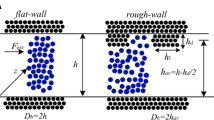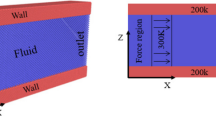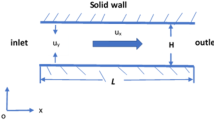Abstract
The effect of rough-wall/fluid interaction on flow in nanochannels is investigated by NEMD. Hydrophobic and hydrophilic surfaces are studied for walls with nearly atomic-size rectangular protrusions and cavities. Our NEMD simulations reveal that the number of liquid atoms temporarily trapped in the cavities is affected by the strength of the potential energy inside the cavities. Regions of low potential energy are possible trapping locations. Fluid atom localization is also affected by the hydrophilicity/hydrophobicity of the surface. Potential energy is greater between two successive hydrophilic protrusions, compared to hydrophobic ones. Moreover, groove size and wall wettability are factors that control effective slip length. Surface roughness and wall wettability have to be taken into account in the design of nanofluidic devices.







Similar content being viewed by others
Abbreviations
- F ext :
-
Magnitude of external driving force
- h :
-
Gap between channel walls
- K :
-
Spring constant
- k B :
-
Boltzman constant
- L x :
-
Length of the computational domain in the x-direction
- L y :
-
Length of the computational domain in the y-direction
- L z :
-
Length of the computational domain in the z-direction
- L s :
-
Slip length
- L s,eff :
-
Effective slip length
- m :
-
Atom mass
- N :
-
Number of atoms
- p :
-
Periodic roughness factor
- r eq :
-
Position of a wall atom on fcc lattice site
- r i :
-
Position vector of atom i
- r ij :
-
Distance vector between ith and jth atom
- T :
-
Temperature
- u(r ij ):
-
LJ potential of atom i with atom j
- V :
-
Volume of the computational domain (L x × L y × L z )
- ε :
-
Energy parameter in the LJ potential
- σ :
-
Length parameter in the LJ potential
- υ w :
-
Fluid velocity at the channel wall
- \( \left\langle {\upsilon_{\text{w}} } \right\rangle \) :
-
Average fluid velocity at the channel wall
References
Cao BY, Chen M, Guo ZY (2006) Liquid flow in surface-nanostructured channels studied by molecular dynamics simulation. Phys Rev E 74:066311
Cao BY, Sun J, Chen M, Guo ZY (2009) Molecular momentum transport at fluid-solid interface in MEMS/NEMS: a review. Int J Mol Sci 10:4638–4706
Cottin-Bizonne C, Barrat J-L, Bocquet L, Charlaix E (2003) Low-friction flows of liquid at nanopatterned interfaces. Nat Mater 2:237–240
Cottin-Bizonne C, Barentin C, Charlaix E, Bocquet L, Barrat J-L (2004) Dynamics of simple liquids at heterogeneous surfaces: molecular dynamics simulations and hydrodynamic description. Eur Phys J E 15:427–438
Galea TM, Attard P (2004) Molecular dynamics study of the effect of atomic roughness on the slip length at the fluid-solid boundary during shear flow. Langmuir 20:3477–3482
Goldstein S (1965) Modern developments in fluid dynamics: an account of theory and experiment relating to boundary layers, turbulent motion and wakes, vol. 2. Dover, New York
Heinbuch U, Fischer J (1989) Liquid flow in pores: slip, no-slip, or multilayer sticking. Phys Rev A 40:1144–1146
Jabbarzadeh A, Atkinson JD, Tarner RI (2000) Effect of the wall roughness on slip and rheological properties of hexadecane in molecular dynamics simulation of Couette shear flow between two sinusoidal walls. Phys Rev E 61:690–699
Kim D, Darve E (2006) Molecular dynamics simulation of electro-osmotic flows in rough wall nanochannels. Phys Rev E 73:051203
Liem SY, Brown D, Clarke JHR (1992) Investigation of the homogeneous-shear non-equilibrium-molecular-dynamics method. Phys Rev A 45:3706–3713
Nagayama G, Cheng P (2004) Effects of interface wettability on microscale flow by molecular dynamics simulation. Int J Heat Mass Trans 47:501–513
Ou J, Perot B, Rothstein JP (2004) Laminar drag reduction in microchannels using ultra hydrophobic surfaces. Phys Fluids 16:4635–4644
Priezjev NV (2007) Effect of surface roughness on rate-dependent slip in simple fluids. J Chem Phys 127:144708
Priezjev NV, Darhuber AA, Troian SM (2005) Slip behavior in liquid films on surfaces of patterned wettability: comparison between continuum and molecular dynamics simulations. Phys Rev E 71:041608
Sbragaglia M, Benzi R, Biferale L, Succi S, Toschi F (2006) Surface roughness-hydrophobicity coupling in microchannel and nanochannel flows. Phys Rev Lett 97:204503
Sofos F, Karakasidis TE, Liakopoulos A (2009a) Effects of wall roughness on flow in nanochannels. Phys Rev E 79:026305
Sofos F, Karakasidis TE, Liakopoulos A (2009b) Transport properties of liquid argon in krypton nanochannels: anisotropy and non-homogeneity introduced by the solid walls. Int J Heat Mass Trans 52:735–743
Tsai P, Peters AM, Pirat C, Wessling M (2009) Quantifying effective slip length over micropatterned hydrophobic surfaces. Phys Fluids 21:12002
Yang SC (2006) Effects of surface roughness and interface wettability on nanoscale flow in a nanochannel. Microfluid Nanofluid 2:501–511
Ziarani AS, Mohamad AA (2008) Effect of wall roughness on the slip of fluid in a microchannel. Nanosc Microsc Therm 12:154–169
Author information
Authors and Affiliations
Corresponding author
Rights and permissions
About this article
Cite this article
Sofos, F., Karakasidis, T.E. & Liakopoulos, A. Surface wettability effects on flow in rough wall nanochannels. Microfluid Nanofluid 12, 25–31 (2012). https://doi.org/10.1007/s10404-011-0845-y
Received:
Accepted:
Published:
Issue Date:
DOI: https://doi.org/10.1007/s10404-011-0845-y




